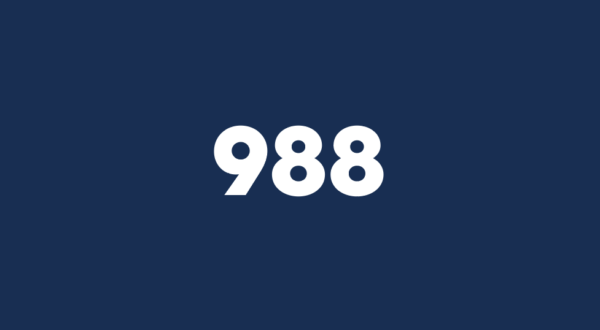Vibrant and 988

988 is now the three-digit dialing code that routes callers to the 988 Suicide & Crisis Lifeline (988 Lifeline) to increase accessibility nationwide. On July 16, 2022, the Lifeline transitioned away from the National Suicide Prevention Line reached through a 10-digit number to the three-digit 988 Lifeline. It is funded by the Substance Abuse and Mental Health Services Administration (SAMHSA) and administered by Vibrant Emotional Health (Vibrant).
The 988 Lifeline is currently active across all communications access points in the United States. If you or someone you know is in crisis or experiencing emotional distress now, please call or text 988, or use our chat service (https://988lifeline.org/chat/).
What is the 988 Lifeline?
The 988 Suicide & Crisis Lifeline (988 Lifeline) provides free and confidential emotional support to people in suicidal crisis or emotional distress 24 hours a day, 7 days a week, across the United States.The 988 Lifeline allows millions of Americans to seek the help they need, while sending the message that healing, hope, and help are happening every day. By serving as the universal dialing code, 988 increases the accessibility of these life-saving interventions and resources.
When the 988 Lifeline is effectively resourced and promoted, it can:
- Connect a person experiencing distress to a trained counselor who can address their immediate needs and help connect them to ongoing care, or local resources
- Reduce health care spending with more cost-effective early intervention
- Reduce use of law enforcement, public health, and other safety resources
- Meet the growing need for crisis intervention at scale
- Help end stigma toward those seeking or accessing mental healthcare
Policy History of the 988 Lifeline Effort
The National Suicide Hotline Designation Act, federal legislation which designated 988 as the three-digit dialing code, was signed into law in October 2020. This triumph was the outcome of many years of activism by the mental health community for the creation of an easy-to-remember telephone number that would increase accessibility of the 988 Lifeline. The Federal Communications Commission has required telephone providers to make calling the Lifeline via 988 accessible as of July 16, 2022.
What’s Next?
988 represents not just a telephone number change for the 988 Lifeline, but a once-in-a-generation opportunity to change how crisis services are delivered. The transition to the 988 Lifeline requires additional policy changes and substantial funding support from federal and state governments. Vibrant has identified three key themes to guide 988 Lifeline implementation:
- Universal and Convenient Access, including omnipresent public awareness and varying modalities for individuals to access the 988 Lifeline through their preferred method of communication.
- High Quality and Personalized Experience that is tailored to the unique needs of the individual while also in line with identified best practices.
- Connection to Resources and Follow Up to ensure all persons contacting the 988 Lifeline receive additional local community resources as needed.
In keeping with these themes, Vibrant has several key recommendations:
It is critical that appropriate funding for the network, individual crisis centers, and the crisis continuum be allocated to serve more people in crisis. States should have a sustainable funding mechanism in place to support their crisis contact centers/crisis services and to better support the people in crisis.
A 988 Fee is the gold standard for sustainable funding and states should strongly consider it.
In 2021, fees for 911 generated $3.4 billion to support that service; similar investment is needed for mental and behavioral health crises. The fee revenue should supplement, not supplant, funding from diverse sources, including federal, state and local governments.
Increased collaboration between 911 and the 988 Lifeline can provide more options for those in crisis, such as dispatching mobile crisis teams to individuals in mental health or suicidal crisis rather than police or EMS, and greater coordination of care options like crisis stabilization units. Such collaborations can reduce the burden on the costly use of hospital emergency departments.
We must also seek to optimize and support services that ensure access and inclusion within 988 Lifeline to meet the unique needs of at-risk groups, including youth, rural populations, BIPOC communities, and LGBTQI+ individuals.
We encourage stakeholders, crisis centers, telecommunications agencies, mental health providers, and people with lived experience to work together to help build this public health safety net for all.
Answer The Call!
The 988 Lifeline suicide and crisis network is made up of over 200 centers answering calls, chats, and texts from people in crisis and experiencing distress. These centers are looking to bring on new volunteers and paid employees. You will receive training, so if you are a caring person who wants to help those in crisis, apply today. Find your opportunity: 988lifeline.org/careers
Documents for Stakeholders
Download 988 Lifeline FAQ factsheet
Read Vibrant Emotional Health’s 988 Projections Report
Vibrant Center Level Cost Estimates
Crisis Centers and Suicide Prevention
FAQs: 988 Lifeline & Crisis Response Services
What Vibrant has said
Joint Letter to FCC: Texting for 988
Vibrant FCC Geolocation Comments
Download 988 Behavioral Health Crisis Care Continuum
Press Releases and Statements
Read Vibrant Emotional Health’s latest press releases here.
Read Vibrant Emotional Health’s latest blog posts here.
Comments are closed here.